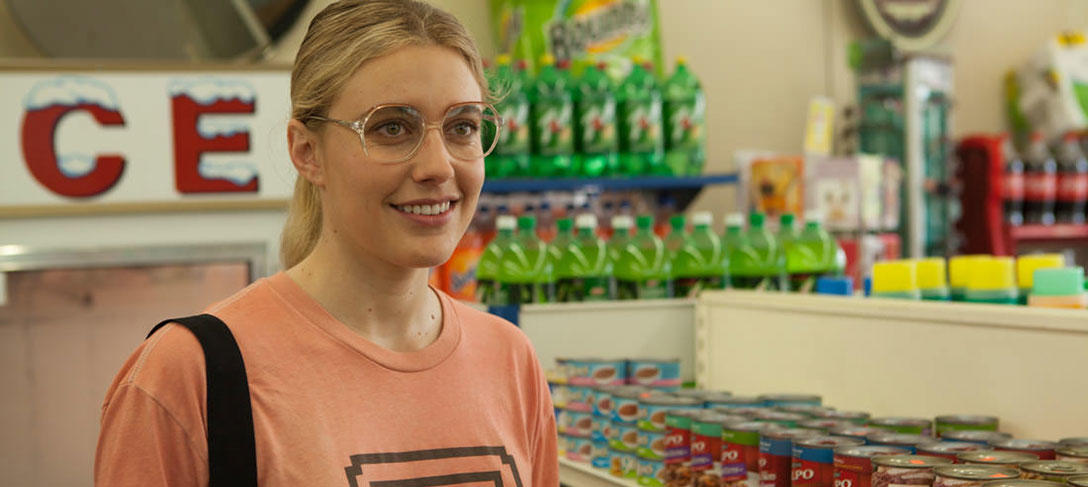Greta Gerwig in ‘Wiener-Dog’
Sundance Institute
Sundance.org is dispatching its writers to daily screenings and events to capture the 10 days of festivities during the 2016 Sundance Film Festival in Park City, Utah. Check back each morning for roundups and insights into our experiences throughout the Festival.
Morris From America
By Jeremy Kinser
Morris from America, a coming-of-age, fish-out-of-water hybrid, is certain to emerge as one the Festival’s most winning selections. The crowd-pleasing comedy from Chad Hartigan premiered at the Eccles Friday in the U.S. Dramatic category to a rapturous response from the audience.

the premiere of ‘Morris From America.’ ©Sundance Institute | Marisa McGrody
Hartigan, who won the Best of NEXT Audience Award for This Is Martin Bonner when it premiered at the 2013 Sundance Film Festival, returns with his third feature. It focuses on Morris (Markees Christmas), a rap-loving 13-year-old from the Bronx who tries to adjust to life in Heidelberg, Germany, with his single father (Craig Robinson), who reminds him they are “the only two brothers” in town. As if he needed a reminder. Surrounded by Teutonic teens, Morris, with his tubby build, mostly keeps his head down and dreams of becoming a rap star. He comes out of his shell under the tutelage and friendly flirtation of a local girl who leads him on a series of misadventures that will test the bond of his relationship with his father.
The two lead actors deliver compelling performances and exhibit chemistry that authenticate their father-son relationship. Robinson, best known for his work in the sitcom The Office and in light comedies such as Pineapple Express and Hot Tub Time Machine, gets to exercise some unexpected dramatic chops. A biting monologue he delivers while driving in a car with his wayward son brought cheers from the audience. Christmas, discovered through a series of YouTube videos, is a major find. He effortlessly holds the camera and convincingly inhabits the character through a series of awkward scenes that saw him delivering sexual-field rap lyrics, and in one scene – which he later told the audience was his least favorite to shoot – found him humping his bed pillow.
At the Q&A that followed the screening, Hartigan informed the audience that the film is, as many suspected, semi-autobiographical. The writer-director, who was raised in Cyprus, said he’d been looking for a movie to make about Europe that would allow him to draw upon his own unique, but relatable coming-of-age experiences as an American youth abroad.
“My personal alienation was [that] I was real smart,” he revealed. “I skipped first grade, and when I was in 8th grade all my classmates were 13 and I was 11 and they were talking sex all the time and getting boners and I had no clue what they were talking about.” Hartigan said this made him feel like he was from a different planet because they were having such different life experiences than he was. He channeled these memories into the screenplay.
“That’s what I was bringing to the movie emotionally, but I wanted to transfer it to something else,” he shared. “I think that came back and it all came together when I started picturing the characters being black in Germany. Obviously the culture barrier that would exist there I could tap into.”
The Bad Kids
By Eric Hynes
For struggling students out in the Mojave Desert in Southern California, Black Rock High School is an oasis – a last best chance for a diploma, and pathway to adulthood. It’s a school that offers an intensely personal and attentive environment for at-risk kids, attempting to shepherd students from a place of “last resort” to self-actualization and success. As it happens, Black Rock was also a kind of oasis for Keith Fulton and Lou Pepe, the veteran directors (Lost in La Mancha, Brothers of the Head) who shot their U.S. Documentary Competition film The Bad Kids in its environs.
“There’s always a time in an artist’s life when you need to reinvent yourself, when you need to go back to the roots of why you do what you do,” Pepe said during his introduction to the film’s world premiere screening at the Temple Theater. “With this film, Keith and I literally made a journey out to the desert to rediscover the kind of filmmaking that mattered to us, and the things in life that mattered to us. Classically, when one makes a journey out to the desert it’s for 40 days and 40 nights. For this film we went for two years, and fell in love with what we found there.”

What they found were charismatic, sincere, thoughtful students dealing with a litany of challenges – poverty, abuse, addiction, depression, parenthood – along with the usual joys and distractions of being a teenager. They also found a fierce and compassionate principal, Vonda Viland, who’s equipped with a seemingly inexhaustible capacity for listening, encouraging, and counseling. “I’m an open book with the students. We talk about everything on a daily basis,” Viland said during the post-screening Q&A, which also featured former students Jennifer and AJ. “The students who need the most love often will show it in the most unloving of ways. So it’s for us to take the time to listen and then give them the love that they need.”
“When we spoke with Vonda Viland about the fact that we thought maybe the students wouldn’t open up to us, she thought that was really funny,” Fulton said. “Because within a couple of days there was an outpouring of stuff. It was almost too much. We were taken aback by how honest the students were.”
According to Jennifer, whose resilience in the face of a troubled family life forms one of the central threads of the film, such honesty was fostered by the dedication and demeanor of the filmmakers. “They entered our lives to make us feel more comfortable with the camera and a big mic,” she said. “Before they got to those intimate moments, they took time to get to know us.”
“I also think that they were just around all the time,” added Viland. “We got used to it, and we forgot that they were there – because they were there for two and a half years.”
Pepe responded to a question regarding how they negotiated making a film in such an emotionally charged environment, where stories turn southward as often as they crescendo, and where the impulse to intervene can be so strong. “It would be emotionally overwhelming for us. It’s hard to get a scene when your soundman is crying,” Pepe said. “As documentary filmmakers, we feel the only way to do it is to have your heart open. And that’s a painful process some days. There were days when we were like, what are we doing with a camera here? So some days you kind of pack it in, and you try and collect yourself and go ‘Oh wait, I’m the storyteller, and maybe I can’t help everybody by solving their problems, but I can get their story out here.’ And then you go back out there with the camera and do it again.”
Wiener-Dog
By Jeremy Kinser
Todd Solondz became the toast of the indie film world in 1996 when Welcome to the Dollhouse, his paean to teen outcasts, premiered at Sundance and went on to win the Grand Jury Prize for best dramatic feature at the Festival. Now 20 years later, Solondz returns with Wiener Dog, which premiered at the Eccles Friday night.
Here the always uncompromising writer-director offers a quartet of very distinctive episodes united by the title character, a rather blithe Dachsund called “Doody” and “Cancer” during the course of the film, who teaches various life lessons to a group of seemingly disparate people across the country. The second segment functions as a quasi-sequel to Dollhouse, with that film’s now-adult characters Dawn and Brandon here portrayed by Greta Gerwig and Kieran Culkin.

Solondz’ off-kilter storytelling drew a strong cast to flesh out these characters, including Ellen Burstyn, Danny DeVito, Julie Delpy, and a pair of actors with Down Syndrome. Ed Lachman’s cinematography adds a luster and a lightness to the proceedings. And a title song by Marc Shaiman and Scott Wittman provides an intermission between the second and third episodes, as the title character takes a jaunty trip across the country, even strolling past the White House at one point.
During the Q&A following the film, Solondz told the audience that he’d hoped to make a film that would land somewhere between Au Hasard Balthazar and Benji.
Gerwig confessed that she was overcome with emotion after seeing the movie for the first time. “People go to film festivals to see stuff like this,” she proclaimed. Devito said he echoed that sentiment.
The director addressed questions from a couple of audience members curious about his decision to revisit characters from Dollhouse, including Dawn Wiener, whom he killed off during his 2004 comedy Palindromes. “One of the nice things about being a writer is you get to do what you want. I like the idea of creating different trajectories, different possible lives Dawn Wiener could have.”
Solondz said he was emphatic that Gerwig and Culkin not try to emulate the young actors who originally played those characters 20 years ago. “It was the emotional quality I was looking for,” he said.




